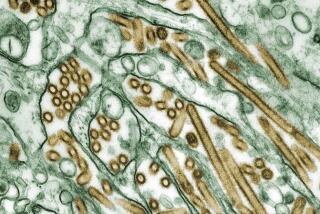FDA reveals 142 cases of tainted scopes
Federal regulators shed more light on the potential harm to patients from a controversial medical scope, disclosing 142 reports of contaminated devices and possible patient infections since 2010.
The Food and Drug Administration had previously said it received about half that many reports, 75, on duodenoscopes that caused patient infections in 2013 and 2014.
The number of patients involved could be far higher than 142 because one adverse event report may include numerous people.
The new details emerged this week in advance of an advisory panel the FDA is convening next week to examine recent scope-related superbug outbreaks at several U.S. hospitals, including ones at UCLA and Cedars-Sinai medical centers.
That FDA panel of medical experts is expected to recommend further steps that regulators, device manufacturers and hospitals should take to protect patients undergoing a procedure known as endoscopic retrograde cholangiopancreatography, or ERCP.
Officials said 669,000 ERCP procedures were performed last year on patients battling cancer, gallstones and other digestive issues.
Both the FDA and Olympus Corp., the leading maker of duodenoscopes, have come under fire from federal lawmakers, doctors and patient advocates for not responding sooner and more forcefully to reports of hospital outbreaks.
Patients were infected even though hospitals were following the manufacturers’ recommended cleaning instructions. Health officials have found that deadly bacteria can become trapped at the tip of these duodenoscopes.
“The transmission of infectious material from patient to patient during ERCP, although uncommon, represents a serious public health concern,” the FDA said in its latest report.
Federal officials acknowledged that their surveillance system for medical devices has limitations and that incidents can be underreported by manufacturers.
Some medical experts agree, and they say the number of scope-related infections may be much higher.
“These reports can come in 18 months to two years later,” said Lawrence Muscarella, a hospital-safety consultant in Montgomeryville, Pa. The FDA’s new figures “could significantly underestimate the risk.”
After a superbug outbreak became public in February at UCLA’s Ronald Reagan Medical Center, the FDA issued a nationwide alert to hospitals and Olympus published revised cleaning instructions.
At UCLA, contaminated Olympus scopes infected seven patients with the CRE superbug and two of them died. Cedars-Sinai reported a similar outbreak in March that sickened four patients treated with an Olympus scope.
Carbapenem-resistant Enterobacteriaceae, or the superbug CRE, is highly resistant to antibiotics, and it can kill up to half of those infected.
A spokesman for Olympus couldn’t be reached for comment Wednesday.
In preparation for the advisory panel debate, the FDA searched its database of adverse event reports filed by scope manufacturers as well as from the makers of equipment that hospitals use to disinfect endoscopes.
Regulators said they found 142 reports related to duodenoscopes from 2010 to Feb. 17, 2015. There were four additional reports going back to 1997.
Among that total of 146 incidents, 13 involved patient deaths and 121 dealt with injuries, according to the FDA. The other reports involved equipment malfunction or other unspecified outcomes.
An FDA spokeswoman said she didn’t have a figure for the total number of patients involved in the ERCP reports.
She said the agency didn’t want to comment further in advance of the advisory panel meeting May 14 and 15
Olympus holds an 85% share of the U.S. market for duodenoscopes and other specialty endoscopes, according to the FDA.
The FDA said six of the nine outbreaks recently investigated by health officials involved Olympus duodenoscopes.
Scopes from Pentax Medical were involved in two outbreaks, and those from Fujifilm were involved in one, according to the FDA.
“There is a systemic risk from this instrument. The problem of underreporting is probably high,” said Dr. James McKinnell, an expert on hospital epidemiology at the L.A. Biomedical Research Institute at Harbor-UCLA Medical Center.
The FDA continued to stand by its decision to not recall the duodenoscopes.
“The agency believes that removal of the device from the market could lead to an insufficient number of available duodenoscopes to meet the clinical demand in the United States,” the agency said in its report. “FDA believes the benefits of the ERCP procedure outweigh the risks in appropriately selected patients.”
The FDA also disclosed for the first time the number of reports it had received on patient infections and device contamination related to automated endoscope reprocessors, the machines many hospitals use to disinfect these reusable devices.
The agency said it had 152 adverse event reports related to reprocessing equipment from 1992 to March 2015.
Custom Ultrasonics, a leading manufacturer of reprocessing machines, has previously said it’s monitoring the scope infections closely, but it has “no concerns regarding the safety and efficacy of our devices.”
Overall, the number of ERCP procedures in the U.S. has grown 15% since 2010 to 668,800 last year, according to industry research cited by regulators.
Twitter: @chadterhune, @melodypetersen
More to Read
Inside the business of entertainment
The Wide Shot brings you news, analysis and insights on everything from streaming wars to production — and what it all means for the future.
You may occasionally receive promotional content from the Los Angeles Times.












